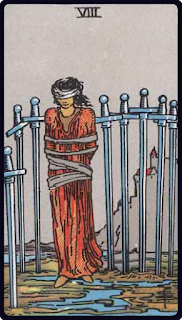
Representing urgency; the 8 of Swords represents the loss of peace and tranquillity, replaced with disturbance once more but with much greater urgency. The 8 of Swords is a sign of trial and tribulation and the need for strength of spirit to endure the return of conflict, with a particular emphasis on course correction where our forward path has not led where we intended it to lead.
In the upright state the 8 of Swords emphasises the need for diplomacy, the impetus to communicate clearly is amplified; the death of our identity as a means to achieve stability as portended by the 4 of Swords makes a return two-fold with the permanent closure of conflict predicted; in the upright state this closure is likely to be positive.
In the inverted state the 8 of Swords warns that the return of conflict is likely to result in defeat which portends to a breakdown of communication and the return of conflict this time beyond resolution, instead an existential threat is posed where the victor will remain, and the defeated element will be removed entirely.
In the Rider-Waite deck the initiate from the 2 of Swords makes a return, here they are bound and stand in judgement with 5 swords to their left rooted in the ground representing the past conflict, 2 swords to their right representing their blind faith and past self, and a single sword in the foreground standing in judgement representing lost opportunity.
In the upright state the swords are rooted in the ground representing the end of conflict, communication is clear, the self is sacrificed, and the conflict comes to an end with surrender. A path forward is possible here.
In the inverted state the swords are upright representing the return of conflict, the initiate once inverted mirrors the Hanged Man and represents the endurance of consequence. Past discretions unforgiven here result in conflict beyond resolution and portends defeat without surrender preventing a path forward, the imminent death of the initiate is implied.
In self-reflection the 8 of Swords serves as a prompt to consider the element of time and the pressures that are associated with it. Quick thinking and effective communication are the result of experience that can be drawn upon but neither of these will develop without practice. Whilst this toolset you are developing is intended to be used in response to negative situations, and such situations by nature are not those you want to place yourself in voluntarily in order to test your skills it can be difficult to gain this experience.
We find ourselves stumped or stumbling most often when we are confronted with situations we have never experienced before or those that were completely unexpected. When asked out of the blue to name 7 singers it’s not unusual to suddenly forget the name of every singer you know - try it now.
If it takes a moment for you to be able to answer the question this is because your stream of consciousness was interrupted and memories that you did not think were pertinent to what you were doing have to be retrieved. This causes a delay and in that moment of delay the spiral of panic can take hold. We need to train ourselves to step back and take a moment of reflection before we act allowing ourselves time to think.
When communication is imperative it is essential that the format and the means of communication are discussed in advance. From an international standpoint we develop protocols to establish a formal set of procedures that should be followed in response to given situations. This process can be arduous and in itself filled with disagreements and debate but the end product is an interface that both parties can use to communicate.
Whilst developing reframing templates for use in CBT s useful they tend to be responses defined ahead of time to be used when things go wrong or when negativity becomes overwhelming. It is worth considering potential responses to positive situations when the scale of that positivity may be overwhelming. Whilst emotion in the moment will override logic and reason, both will eventually return when the emotional high wears off and the reality of our actions can then trigger negativity.
This does not mean developing reframing templates for positive situations, but instead this is your prompt to consider how you will react when things go right. Planning ahead for positive outcomes will help ground your decision-making processes and limit the potential negative impact.
Consider an investment with financial risk for instance, whilst planning ahead for the potential negative outcomes is wise allowing you to mitigate the risk, and whilst a positive outcome in itself is not a problem to be solved, it is worth planning ahead and considering what you will do if your investment pays off.
This doesn’t mean you have to plan out where every penny will be spent, but by having some baseline achievement you will build a foundation and effectively create a safety net below which negativity could fall. For example, planning to reinvest half or a quarter of your return will ensure whatever you do with the rest even if all of it is then lost, you will have that partial reinvestment as an emotional safety net serving as something to show for your efforts.
Ask yourself “What will I do if things go right?” or “How will I make the most of this?” and consider the potential positive outcomes and how you would react. You are already preparing for the negative, do not fail to recognise the positive and take the opportunity to enjoy it when it comes.

No comments:
Post a Comment
All comments are moderated before they are published. If you want your comment to remain private please state that clearly.